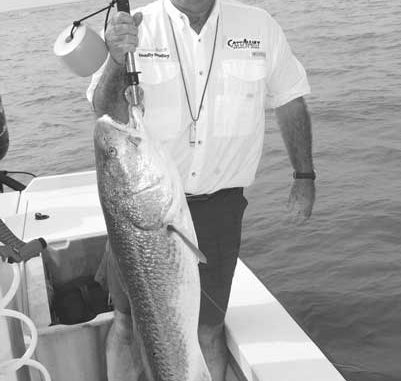
Don’t let the name scare you away. You’ll swat more redfish than bugs at Mosquito Bay.
Beginning in August and extending into October is the annual “bull-red run.” During this time, most of Louisiana’s passes and channels into the Gulf of Mexico will witness the twinkling of lights from anglers’ boats as they fish the nighttime hours for the bronze-skinned, heavyweight sluggers.
The term “bull red” is used by fishermen in reference to the size of an individual redfish, more properly known as red drum, rather than its gender. At least half of all bull reds are in actuality females.
Generally, in years gone by, a redfish was considered a bull red if it was larger than 10 pounds. Smaller fish were called “rat reds,” a term not now heard as often as before. The 10-pound marker point is not as uniformly accepted as before either, with some anglers not considering a fish to be a bull red until it is 15 pounds or even larger.
Redfish, during their life cycle, use both inshore coastal marshes and offshore waters. After hatching and reaching sizes where they can swim and actively feed, very small redfish thrive in inshore habitats. The very best habitats are sea grass beds and edge areas where marsh grasses meet open water. Open mud or sand bottoms, and even oyster reefs, are far less desirable to small redfish.
The size of each year class or annual crop will be largely determined during its first year, while the fish are in shallow marsh waters. Many factors can affect survival, but the most obvious one to anglers is the number and severity of winter freezes. But the reasons for weak and poor year classes are much more complicated than cold weather and are poorly understood by scientists. Cold winter weather does, however, slow the growth rate of young redfish.
Under average conditions, their growth is explosive. At 1-year-old, a redfish can be 13-16 inches long. By age 2, a few faster-growing individuals can be 22-27 inches long, and have left the inshore marshes and joined the schools of mature redfish that prowl offshore waters.
Migration from inshore marshes to offshore schools is strongly related to size and maturity. At age 4, half of the fish are mature. By age 5 for male redfish and age 6 for females, even the late-maturing fish are mature and can spawn.
While mature fish generally spend most of their time in offshore schools, it is quite common to find individual fish making forays into inshore waters at any time of the year for reasons known only to themselves.
There is some indication that smaller mature redfish form discrete schools separate from larger mature fish. Whether this is due to smaller fish targeting different foods than larger fish or to intra-species competition or aggression isn’t known.
Most fishermen correctly assume that the August to October bull-red run has something to do with the species’ spawning activities. During this period, redfish spawn at night, typically in passes and channels with high salinities and substantial currents. There, males stake out the prime spawning locations for eight to 10 weeks, waiting for females with ripe eggs to venture in.
These males form large schools called spawning aggregations. In these spawning aggregations, the males noisily vibrate their tough air bladders, in an activity called drumming, to attract the gentler sex. Females will produce a batch of ripe eggs every two to seven (average four) days. Between each spawning, females spend their time elsewhere foraging. Males will attempt to spawn every night and, therefore, spend all their time during the run in passes or in nearby coastal waters.
Since males largely spend almost all their time in and near passes and females venture in for only a few hours every fourth night or so, bull red anglers catch many more males than females during the run. This should assuage the consciences of those anglers who fret over the effect of catching “spawners.”
For redfish, the number of eggs produced per pound of body weight increases as the fish get larger, making larger spawners more important, pound-for-pound, for the spawning potential of the species, than smaller fish. This is unlike speckled trout and black drum, which produce fewer eggs per pound of body weight as they get older and larger.
A female redfish has an annual egg production that can only be described as stupendous — 20 to 40 million eggs per season. Multiplied by the tens of thousands of mature female redfish that spawn each season, the total egg production makes the numbers that would have been killed by the proposed (and abandoned) open-loop, liquefied natural gas (LNG) platforms look like an almost invisible blip on the radar screen.
Jerald Horst is an author of the Angler’s Guide to Fishes of the Gulf of Mexico, a 444-page, color-illustrated book on fishes written for saltwater fishermen. The book is available in better bookstores or can be ordered by calling 800-843-1724.


